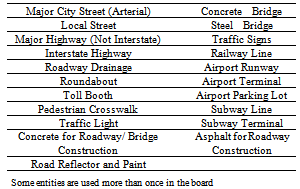-
Paper Information
- Previous Paper
- Paper Submission
-
Journal Information
- About This Journal
- Editorial Board
- Current Issue
- Archive
- Author Guidelines
- Contact Us
International Journal of Traffic and Transportation Engineering
p-ISSN: 2325-0062 e-ISSN: 2325-0070
2013; 2(3): 31-36
doi:10.5923/j.ijtte.20130203.02
Transportation-OPOLY: An Innovative Tool to Promote Transportation Engineering
1Department of Civil Engineering, University of South Alabama, Mobile, AL 36688, USA
2Environmental Resources Management, Mobile, AL 36609, USA
Correspondence to: Samantha Islam, Department of Civil Engineering, University of South Alabama, Mobile, AL 36688, USA.
| Email: |  |
Copyright © 2012 Scientific & Academic Publishing. All Rights Reserved.
There has been a decline in the number of transportation professionals in the United States. This decline can be attributed to the fact that the number of people retiring in this profession exceeds the number of young people entering this profession. To generate interest among rising middle and high school students in transportation profession, a program called the Youth Transportation Institute (YTI) has been developed at the University of South Alabama. The major highlight of YTI activities is the Transportation-OPOLY board game. Transportation-OPOLY is an entertaining, process-oriented tool to introduce young students to the various systems that transportation engineers deal with regularly. In the game, each player plays the role of a transportation engineer. Before playing the game, the young players participate in a series of activities designed to provide a general overview of transportation system and transportation engineering as a career. In the summer of 2012, the board game was utilized in a summer camps as a pilot test. A short comprehensive evaluation was conducted at the end of the activity to assess the acceptability and impact of the game upon the participating students. A positive response was obtained from the assessment.
Keywords: Transportation Engineering, Transportation Infrastructure, Outreach, Board Game
Cite this paper: Samantha Islam, Sarah Brown, Transportation-OPOLY: An Innovative Tool to Promote Transportation Engineering, International Journal of Traffic and Transportation Engineering, Vol. 2 No. 3, 2013, pp. 31-36. doi: 10.5923/j.ijtte.20130203.02.
Article Outline
1. Introduction
- Studies show that fewer students enter into and persist in the engineering degree programs than in other programs in the United States[1, 2]. According to these studies, this problem is even more pronounced among minorities and students from low-income families. Civil engineering, like other engineering discipline, is facing similar problem[3]. One of the often cited reasons for the shortage of students in the engineering programs is the lack of knowledge and exposure to the opportunities in the engineering field[2]. Transportation engineering is a major sub-discipline of civil engineering. This branch of civil engineering is concerned with moving people and goods efficiently, safely, and in a manner conducive to a vibrant community[4]. Transportation engineers specify, design, construct, and maintain transportation infrastructure which includes streets, canals, highways, rail systems, airports, ports, and mass transit. Therefore, for proper functioning of our society, there is a need for more talented and dedicated transportation engineers capable of maintaining our existing transportation infrastructure and designing and building new safe and efficient transportation facilities. Literature shows that there has been a decline in the number of transportation professionals[5, 6, 7].This decline can be attributed to the fact that the number of people retiring in this profession is more than the number of young people entering this profession.The civil engineering program at the University of South Alabama (USA), located in Mobile, Alabama, is a major center of higher education in civil engineering in the upper Gulf Coast region of the United States. This program at the University of South Alabama is the only quality civil engineering program within 150 miles radius of Mobile[1]. If proper initiative is taken, this program can motivate students from the southern part of Alabama, southeastern part of Mississippi, and northwestern part of Florida to pursue career in transportation and other areas of civil engineering. Recently, one such initiative has been taken at the University of South Alabama to motivate middle and high school students of Southeast Alabama to pursue a future in the transportation engineering profession[8]. This initiative is called the Youth Transportation Institute (YTI). One of the major highlights of YTI is the Transportation- OPOLY game, a board game developed based on the popular MONOPOLY game. Transportation-OPOLY is an entertaining, process-oriented tool to introduce young individuals to the various systems that transportation engineers deal with regularly. This paper introduces the readers, a majority of whom are present or future transportation professionals, to the Transportation-OPOLY board game.
2. Knowledge Development
- The Transportation-OPOLY game provides each player an opportunity to play the role of a transportation engineer who deals with the transportation needs of a city.However, a majority of the young participants of YTI are not familiar with a transportation engineer’s task. Therefore, Transportation-OPOLY has been tied to a knowledge development process designed to provide young participants the knowledge needed to play the game. The fun filled process involves a series of presentation and hands-on examples and challenge activities designed to provide a general overview of transportation system and transportation engineering as a career. The following sections provide a brief overview of the knowledge development process.
2.1. Presentations
- Before playing the Transportation-OPOLY game, young YTI participants attend the following presentations:•Job of a transportation engineer•Overview of transportation design and urban planning•Traffic/road signs•Highway design •Bridge design•Transportation materialsThe YTI program provides participants the opportunity to meet invited local transportation professionals. These invited professionals use colorful graphics and videos to describe what transportation engineers do. The participants also learn from them about local transportation projects and job that are locally available for transportation engineers.The transportation design and urban planning presentation is designed to provide young audiences an overview of the engineering designs transportation engineers are involved in. Also, this presentation gives them a general idea of the urban planning processes.Using aerial photos of the downtown area of Mobile, Alabama, students observe how roads, bridges, and overpasses are woven into the surrounding city.In short, this presentation shows how transportation engineers cater to the community they serve and facilitates the city’s operations. At the end of this presentation participants are asked to develop small cities with efficient transportation network using an urban planning simulation program called the SimCity. This activity is described later in this paper.The traffic/ road sign presentation discusses commonly used traffic symbols and their history. Specifically, the discussion covers how transportation engineers decide when and where to place a road sign, and the meaning of the colors of road signs. At the end of the presentation, the participants break into groups and make traffic signs of their own using given poster boards and markers.The highway design presentation informs the young audiences about different types of roadways. It discusses the history and scope of the United States interstate system.In addition, it discusses various aspects of highway layouts and geometric designs.The young individuals are informed how highways are laid out using a variety of geometric forms such as tangents, horizontal curves and vertical curves.The young participants also learn about the makeup of roadway cross-section: sub-grade, sub-base, base and wearing surface.After the presentation, participants take part in an activity that involves them in building road cross-sections in the lab as described later in this paper.Bridge design presentation introduces different types of bridges and discusses factors considered in the selection of each type. Also, it gives a general overview of the major factors that influence the design of a bridge. After the presentation, each participant gets a taste of designing a very simple bridge using the “West-Point Bridge Designer” software as described later in this paper.Transportation materials presentation discusses the properties and use of transportation materials.Such materials include:concrete, asphalt, wood and steel.Following the presentation, students take part in the compressive strength testing of concrete.
2.2. Hands-on Activities
- In addition to attending the aforementioned presentations, the young participants also participate in various hands-on interactive activities before playing the Transportation-OPOLY board game. These activities are discussed in the following paragraphs. Use of simulation in teaching has been found to be a very effective technique for increasing student motivation for learning science and engineering concepts (9, 10). After attending the presentation on transportation design and urban planning, the young participants have an opportunity to develop their own city using a computer simulation called “Sim City”. The “Sim City” is an excellent computer simulation software that allows users to create their own cities from scratch. The software is suitable for upper elementary school students and above. The participants create virtual cities that they control on a landscape generated by the computer. In the city, the participants create residential, industrial, and commercial zones at suitable locations for the inhabitants (Sims) to live, work and shop/conduct business respectively. Also, they create roads to connect the different zones together so that the inhabitants (Sims) can travel between work, shopping or home. This activity provides the participants an appreciation of the urban planning process. Figure 1 shows a virtual city created by the “Sim City” program.Following the highway design presentation, the participants take part in a laboratory activity to build a roadway cross-section. A typical roadway cross-section consists of several layers: (i) soil sub-grade layer; (ii) gravel sub-base layer; (iii) base layer made of finer gravel or stones; and (iv) asphalt concrete wearing surface layer. The participants are broken into groups. Each group builds a roadway cross-section in a plexiglass box as shown in Figure 2 using the materials provided to them.
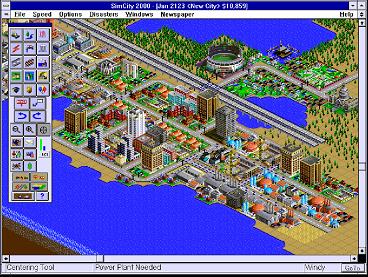 | Figure 1. Development of a city using the “SimCity” computer program |
 | Figure 2. Roadway cross-section laboratory activity |
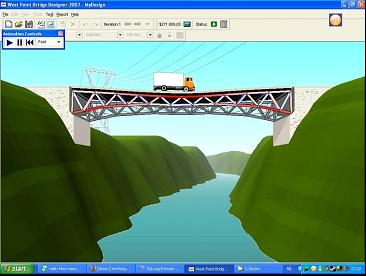 | Figure 3. Simple analysis using “West Point Bridge Designer” |
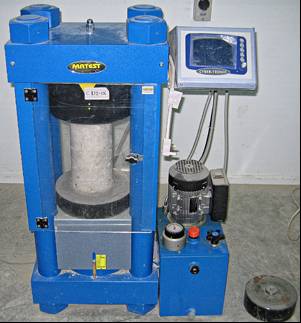 | Figure 4. Compressive strength test of concrete |
3. Design and Conduct of Transportation-OPOLY
- The Transportation-OPOLY board game has been designed to introduce young individuals to the world of transportation engineering. The following sections describe the design of the game and how to set up and conduct the game.
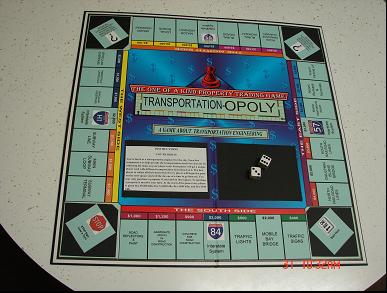 | Figure 5. Transportation-OPOLY board game |
3.1. Design of Transportation-OPOLY
- As stated earlier, Transportation-OPOLY is based on the popular MONOPOLY game. The equipment includes a board, two dice, tokens, play money, and player cards. The game board consists of thirty two spaces containing twenty-eight transportation infrastructure entities or activities and four corner squares as shown in Figure 5. The infrastructure entities are listed in Table 1. The players become familiar with the infrastructure entities during the knowledge building process of YTI as discussed earlier in this paper. Four corner squares consist of a Start space, a Stop space and two Chance spaces. The board is printed on a heavy plastic-like material to replicate the more substantial look and feel of a typical board game. The Transportation-OPOLY game is designed for two to five players.
3.2. Game Setting and Conduct
- In Transportation-OPOLY, each player is hired as a transportation engineer, and his or her goal is to collect the transportation needs of a city. At the beginning of the game, each player receives a card that lists several infrastructure entities that are the current needs of his/her city. During the course of the game he/she spends his/her allocated money to buy those entities to satisfy the city’s need. The first player to collect all the properties listed on his/her card wins. The steps of the Transportation-OPOLY game are listed below in detail:• The board is placed on a table or floor space. • Each player receives a player card and money. • Each rolls the dice to see who goes first. The player with the highest number on the initial roll starts the game.• Starting from the GO space, each player on his/her turn rolls the dice and advances that number of spaces. • A player can buy the space he/she lands on, if it is not owned by any other player. However, if someone else already owns the space, the player pays him/her a rent or buys it at a higher price if the current owner agrees. • If a player lands on STOP space, he/she looses a chance to advance.• During the course of the game, each player is entitled to collect a salary each time he/she passes GO.• If a player spends all his money before obtaining all the entities in his card, his game is over. However, the remaining players continue to play. • The first player to collect all the properties listed on his/her card wins.
|
4. Assessment of Transportation- OPOLY
- Transportation-OPOLY was developed in 2011. In the summer of 2012, the board game was incorporated into Summer Camp in Robotics, Engineering and Mathematics (SCREAM), a summer camp held at the University of South Alabama. The objective of SCREAM was to introduce engineering and robotics concepts to young participants while reinforcing their math and science skills. A total of 26 young students from various local schools participated in the summer camp. Transportation-OPOLY was scheduled for the second day of the camp. In the morning and early afternoon sessions, the young participants of the camp participated in the knowledge building process to learn about transportation engineering. In the late afternoon, they broke into several groups of four or five participants to play Transportation-OPOLY. During the game session, students seem very engaged and energized. After the game, students were assessed to collect feedback of the Transportation-OPOLY game using a simple survey as shown in Table 2. Result of the survey is provided in Figure 6. As seen in Figure 6, the result of the survey was positive and indicated that the majority of the students enjoyed playing the Transportation-OPOLY game. More importantly, as the results indicate, the board game was able to generate interest in transportation engineering in majority of the young participants.
|
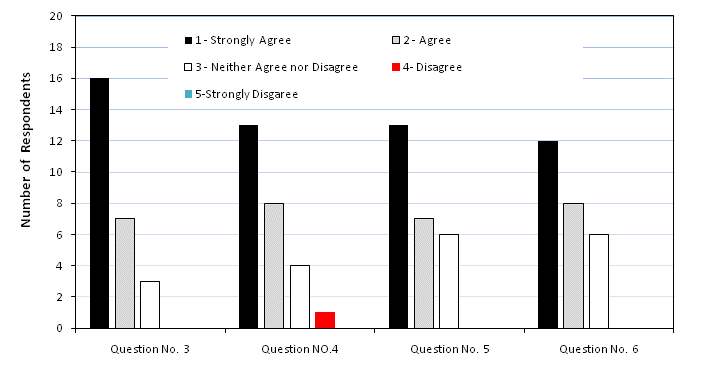 | Figure 6. Assessment results for Transportation-OPOLY |
5. Future Work
- Infuture, the authors intend make the knowledge development process of YTI more interesting and informative by including presentations on the current major developments in the field of transportation engineering. Such presentations will include topics such as intelligent transportation system (ITS), advanced highway materials, etc. As stated earlier, the Transportation-OPOLY board game has been tested only once for its effectiveness. In future, through more extensive and aggressive outreach, young students from various parts of Southeast Alabama will be attracted for further testing of the game to ensure that it performs as intended.
6. Summary and Conclusions
- There has been a decline in the number of transportation professionals in the United States. One of the major reasons for this decline is that fewer students enter into and persist in this area of engineering than in other areas. This problem can be addressed by generating interest in transportation engineering among young students. One such attempt is the Youth Transportation Institute (YTI), an initiative taken at the University of South Alabama to promote transportation engineering among rising middle and high school students. The major highlight of YTI activities is the Transportation-OPOLY game, a board game developed based on the popular MONOPOLY game. The Transportation-OPOLY board game is expected to be an effective instrument for demonstrating the different aspects of transportation engineering to young individuals. The game equipment includes a board, two dice, tokens, play money, and player cards. In Transportation-OPOLY, each player plays the role of a transportation engineer working for a city. During the course of the game he/she utilizes his/her allocated money to purchase infrastructure entities to satisfy the city’s transportation need. Before playing the game, the young participants attend a series of presentations and hands-on activities to become familiar with the job of a transportation engineer. In the summer of 2012, the board game was first utilized in a summer camps as a pilot test. A short comprehensive evaluation was conducted at the end of the activity to assess the acceptability and impact of the game upon the participating students. Student’s response indicated that they enjoyed the game and majority of them became interested in transportation engineering. Although Transportation-OPOLY has been designed for the young students of the Gulf Coast region, it can be used in other regions as well to increase student motivation for learning about transportation engineering.
ACKNOWLEDGEMENTS
- The work described in this paper was supported by the University Committee on Undergraduate Research (UCUR) at the University of South Alabama.
 Abstract
Abstract Reference
Reference Full-Text PDF
Full-Text PDF Full-text HTML
Full-text HTML